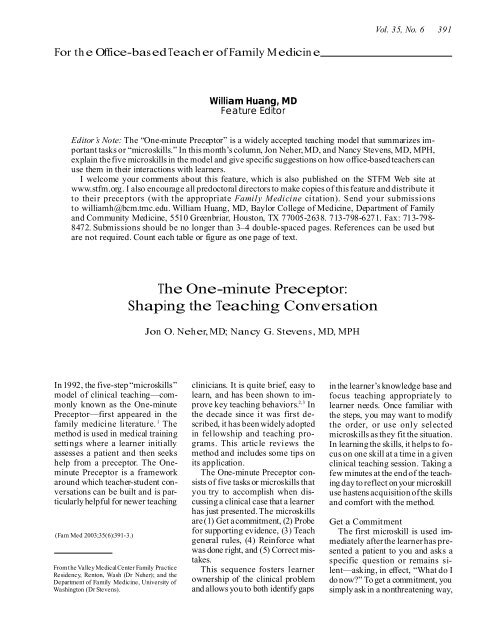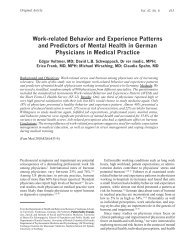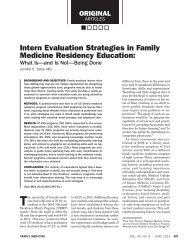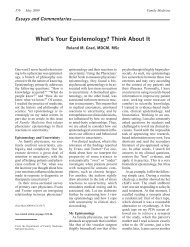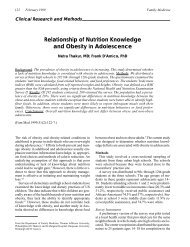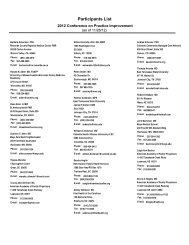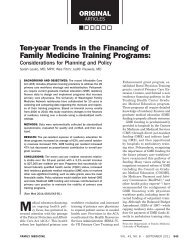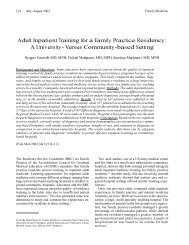The One-minute Preceptor: Shaping the Teaching ... - STFM
The One-minute Preceptor: Shaping the Teaching ... - STFM
The One-minute Preceptor: Shaping the Teaching ... - STFM
Create successful ePaper yourself
Turn your PDF publications into a flip-book with our unique Google optimized e-Paper software.
For <strong>the</strong> Office-based Teacher of Family Medicine<br />
William Huang, MD<br />
Feature Editor<br />
Vol. 35, No. 6<br />
Editor’s Note: <strong>The</strong> “<strong>One</strong>-<strong>minute</strong> <strong>Preceptor</strong>” is a widely accepted teaching model that summarizes important<br />
tasks or “microskills.” In this month’s column, Jon Neher, MD, and Nancy Stevens, MD, MPH,<br />
explain <strong>the</strong> five microskills in <strong>the</strong> model and give specific suggestions on how office-based teachers can<br />
use <strong>the</strong>m in <strong>the</strong>ir interactions with learners.<br />
I welcome your comments about this feature, which is also published on <strong>the</strong> <strong>STFM</strong> Web site at<br />
www.stfm.org. I also encourage all predoctoral directors to make copies of this feature and distribute it<br />
to <strong>the</strong>ir preceptors (with <strong>the</strong> appropriate Family Medicine citation). Send your submissions<br />
to williamh@bcm.tmc.edu. William Huang, MD, Baylor College of Medicine, Department of Family<br />
and Community Medicine, 5510 Greenbriar, Houston, TX 77005-2638. 713-798-6271. Fax: 713-798-<br />
8472. Submissions should be no longer than 3–4 double-spaced pages. References can be used but<br />
are not required. Count each table or figure as one page of text.<br />
In 1992, <strong>the</strong> five-step “microskills”<br />
model of clinical teaching—commonly<br />
known as <strong>the</strong> <strong>One</strong>-<strong>minute</strong><br />
<strong>Preceptor</strong>—first appeared in <strong>the</strong><br />
family medicine literature. 1 <strong>The</strong><br />
method is used in medical training<br />
settings where a learner initially<br />
assesses a patient and <strong>the</strong>n seeks<br />
help from a preceptor. <strong>The</strong> <strong>One</strong><strong>minute</strong><br />
<strong>Preceptor</strong> is a framework<br />
around which teacher-student conversations<br />
can be built and is particularly<br />
helpful for newer teaching<br />
(Fam Med 2003;35(6):391-3.)<br />
From <strong>the</strong> Valley Medical Center Family Practice<br />
Residency, Renton, Wash (Dr Neher); and <strong>the</strong><br />
Department of Family Medicine, University of<br />
Washington (Dr Stevens).<br />
<strong>The</strong> <strong>One</strong>-<strong>minute</strong> <strong>Preceptor</strong>:<br />
<strong>Shaping</strong> <strong>the</strong> <strong>Teaching</strong> Conversation<br />
Jon O. Neher, MD; Nancy G. Stevens, MD, MPH<br />
clinicians. It is quite brief, easy to<br />
learn, and has been shown to improve<br />
key teaching behaviors. 2,3 In<br />
<strong>the</strong> decade since it was first described,<br />
it has been widely adopted<br />
in fellowship and teaching programs.<br />
This article reviews <strong>the</strong><br />
method and includes some tips on<br />
its application.<br />
<strong>The</strong> <strong>One</strong>-<strong>minute</strong> <strong>Preceptor</strong> consists<br />
of five tasks or microskills that<br />
you try to accomplish when discussing<br />
a clinical case that a learner<br />
has just presented. <strong>The</strong> microskills<br />
are (1) Get a commitment, (2) Probe<br />
for supporting evidence, (3) Teach<br />
general rules, (4) Reinforce what<br />
was done right, and (5) Correct mistakes.<br />
This sequence fosters learner<br />
ownership of <strong>the</strong> clinical problem<br />
and allows you to both identify gaps<br />
391<br />
in <strong>the</strong> learner’s knowledge base and<br />
focus teaching appropriately to<br />
learner needs. Once familiar with<br />
<strong>the</strong> steps, you may want to modify<br />
<strong>the</strong> order, or use only selected<br />
microskills as <strong>the</strong>y fit <strong>the</strong> situation.<br />
In learning <strong>the</strong> skills, it helps to focus<br />
on one skill at a time in a given<br />
clinical teaching session. Taking a<br />
few <strong>minute</strong>s at <strong>the</strong> end of <strong>the</strong> teaching<br />
day to reflect on your microskill<br />
use hastens acquisition of <strong>the</strong> skills<br />
and comfort with <strong>the</strong> method.<br />
Get a Commitment<br />
<strong>The</strong> first microskill is used immediately<br />
after <strong>the</strong> learner has presented<br />
a patient to you and asks a<br />
specific question or remains silent—asking,<br />
in effect, “What do I<br />
do now?” To get a commitment, you<br />
simply ask in a nonthreatening way,
392 June 2003 Family Medicine<br />
“What do you think is going on?”<br />
or “What do you want to do?” Your<br />
objective is to get <strong>the</strong> learner to process<br />
<strong>the</strong> information he or she has<br />
just collected concerning <strong>the</strong> patient.<br />
Occasionally, you will need to<br />
ask one or two clarifying questions<br />
about <strong>the</strong> presentation before you<br />
ask for a commitment. Questions<br />
such as “Does <strong>the</strong> child have a fever?”<br />
are reasonable, but avoid <strong>the</strong><br />
temptation to ask so many questions<br />
that you take over <strong>the</strong> case.<br />
Often, you can teach learners to<br />
begin with a commitment. This<br />
saves time in precepting, helps<br />
learners identify <strong>the</strong>ir own areas of<br />
weakness, and allows you to attend<br />
to key clinical details during <strong>the</strong><br />
case presentation.<br />
Making a commitment can be<br />
difficult for some learners because<br />
of <strong>the</strong> risk of being wrong and concerns<br />
about being evaluated. <strong>The</strong><br />
question, “What if I weren’t available,<br />
what would you do for this<br />
patient?” will often get around this<br />
impasse. A general statement to <strong>the</strong><br />
learner before you start—“I am particularly<br />
interested in what you are<br />
thinking because it helps me be a<br />
better teacher”—may encourage<br />
<strong>the</strong>m to share <strong>the</strong>ir thinking more<br />
openly.<br />
For more-advanced learners, remember<br />
that commitments may focus<br />
on any aspect of clinical care,<br />
including diagnosis, diagnostic<br />
trees, treatment plans, follow-up,<br />
etc. Learners should be constantly<br />
challenged to make intellectual<br />
commitments just beyond <strong>the</strong>ir<br />
level of comfort. In very complex<br />
cases, commitment requests may<br />
take <strong>the</strong> form of “How do you plan<br />
to find <strong>the</strong> diagnosis?” or “What do<br />
you plan to write for admission orders?”<br />
or “How are you going to<br />
chip away at this situation?”<br />
Probe for Supporting Evidence<br />
Next, you ask <strong>the</strong> learner what<br />
underlies his/her commitment. This<br />
has been described as exploring <strong>the</strong><br />
learner’s “mind map,” pieces of information<br />
(basic science or clinical)<br />
that may be loosely connected to<br />
each o<strong>the</strong>r. 4 To explore <strong>the</strong> learner’s<br />
fund of knowledge and ability to<br />
connect different pieces of information<br />
on his or her mind map, you<br />
can ask questions such as, “What<br />
factors did you consider in making<br />
that decision?” or “Were <strong>the</strong>re o<strong>the</strong>r<br />
options you considered and discarded?”<br />
Listening carefully allows<br />
you to understand <strong>the</strong> learner’s<br />
clinical reasoning and to find deficits<br />
in his or her knowledge base.<br />
For a reluctant or resistant learner,<br />
you may find fur<strong>the</strong>r elaborations<br />
helpful. 5 Questions like, “If this<br />
patient was pregnant, would it alter<br />
your management?” or “What are<br />
your thoughts on <strong>the</strong> risks and benefits<br />
of empirical treatment as opposed<br />
to obtaining a definitive diagnosis<br />
first?” can bring out <strong>the</strong><br />
learner’s thinking and knowledge.<br />
Teach General Rules<br />
Every case has teaching value,<br />
and your goal is to target your teaching<br />
appropriately. Once you understand<br />
what <strong>the</strong> learner knows, you<br />
are in a position to teach one or<br />
more general rules, which are targeted<br />
to <strong>the</strong> current case but also<br />
generalize to o<strong>the</strong>r, similar cases.<br />
For example, “It is well established<br />
that ACE inhibitors reduce morbidity<br />
and prolong life in patients with<br />
dilated cardiomyopathy” is more<br />
appropriate than “This patient needs<br />
captopril.” Your general rules might<br />
summarize anything from <strong>the</strong> key<br />
features of a particular diagnosis,<br />
<strong>the</strong> management of a demanding<br />
patient, or effective use of phone<br />
consultation.<br />
A common problem for new<br />
teachers is trying to teach everything<br />
on one case. Learners cannot<br />
integrate more than a few general<br />
rules per case, so focus on <strong>the</strong> important<br />
areas for <strong>the</strong>m and <strong>the</strong> patient.<br />
Avoid <strong>the</strong> temptation to focus<br />
primarily on what you know best.<br />
Also, learners with little knowledge<br />
in an important clinical area, where<br />
<strong>the</strong>ir commitment is a blind guess<br />
and <strong>the</strong>y offer no supporting evidence,<br />
may need more than a quick<br />
“sound bite.” If time allows, a minilecture<br />
may be useful, or you may<br />
need to assign reading or plan a review<br />
session with <strong>the</strong> learner in <strong>the</strong><br />
future. In a busy clinic, <strong>the</strong> most<br />
helpful general rules may be just<br />
how to get through <strong>the</strong> day.<br />
Reinforce What Was Done<br />
Right/Correct Mistakes<br />
<strong>The</strong> final two steps of <strong>the</strong> teaching<br />
conversation are verbally reinforcing<br />
those behaviors that were<br />
highly effective and suggesting new<br />
behaviors that may be helpful in <strong>the</strong><br />
future. As with all feedback, it<br />
should be well timed, expected,<br />
case specific, and behavior focused<br />
and utilize descriptive ra<strong>the</strong>r than<br />
evaluative language. 6<br />
Since we all learn most from <strong>the</strong><br />
mistakes we identify ourselves, one<br />
strategy is to ask <strong>the</strong> learners to<br />
identify what <strong>the</strong>y did right and<br />
what <strong>the</strong>y would like to do better.<br />
Ano<strong>the</strong>r is to ask learners in advance<br />
how <strong>the</strong>y like to get feedback.<br />
This lets <strong>the</strong>m know <strong>the</strong>y will be<br />
getting feedback and invites <strong>the</strong>ir<br />
participation in <strong>the</strong> process.<br />
Ano<strong>the</strong>r variation is to give some<br />
positive feedback early in <strong>the</strong> teaching<br />
conversation, before probing for<br />
supporting evidence, to reduce<br />
learner performance anxiety. If you<br />
find you are never getting to <strong>the</strong><br />
feedback steps as you work toge<strong>the</strong>r,<br />
try setting aside a specific<br />
time for feedback (for example, after<br />
all observed encounters or observed<br />
pro cedures), allowing<br />
teacher and learner to sit down and<br />
discuss “how it went in <strong>the</strong>re.”<br />
In summary, <strong>the</strong> <strong>One</strong>-<strong>minute</strong> <strong>Preceptor</strong><br />
model continues to provide<br />
a reliable framework on which good<br />
teaching conversations can be built.<br />
<strong>The</strong> model is most helpful when it<br />
is not viewed as static and rigid but<br />
as a pliable set of guidelines that can
For <strong>the</strong> Office-based Teacher of Family Medicine<br />
be shuffled and altered as <strong>the</strong> everchanging<br />
teaching situation warrants.<br />
You can acquire <strong>the</strong>se<br />
microskills yourself with practice<br />
and reflection on your own teaching<br />
encounters.<br />
Corresponding Author: Address correspondence<br />
to Dr Neher, Valley Medical Center<br />
Family Practice Residency, 3915 Talbot Road<br />
South, Suite #401, Renton, WA 98055. 425-<br />
656-4287. Fax: 425-656-5395. jneher@vmc.<br />
fammed.washington.edu.<br />
REFERENCES<br />
1. Neher JO, Gordon KC, Meyer B, Stevens<br />
N. A five-step “microskills” model of clinical<br />
teaching. J Am Board Fam Pract 1992;<br />
5:419-24.<br />
2. Furney SL, Orsini AN, Orsetti KE, Stern DT,<br />
Gruppen LD, Irby DM. <strong>Teaching</strong> <strong>the</strong> <strong>One</strong><strong>minute</strong><br />
<strong>Preceptor</strong>: a randomized controlled<br />
trial. J Gen Intern Med 2001;16:620-4.<br />
3. Salerno SM, O’Malley PG, Pangaro LN,<br />
Wheeler GA, Moores LK, Jackson JL. Faculty<br />
development seminars based on <strong>the</strong><br />
Vol. 35, No. 6<br />
393<br />
<strong>One</strong>-<strong>minute</strong> <strong>Preceptor</strong> improve feedback in<br />
<strong>the</strong> ambulatory setting. J Gen Intern Med<br />
2002;17:779-87.<br />
4. Neighbor WE Jr, Dobie SA. Microskills<br />
model of clinical teaching. J Am Board Fam<br />
Pract 1993;6:86-7.<br />
5. Ferenchick G, Simpson D, Blackman J,<br />
DaRosa D, Dunnington G. Strategies for efficient<br />
and effective teaching in <strong>the</strong> ambulatory<br />
care setting. Acad Med 1997;72:277-<br />
80.<br />
6. Ende J. Feedback in clinical medical education.<br />
JAMA 1983;250:777-81.


